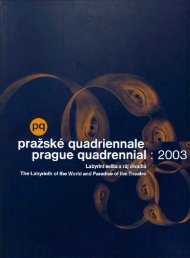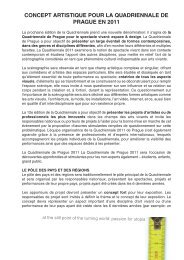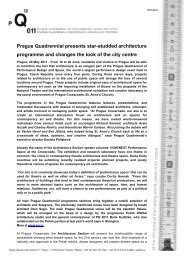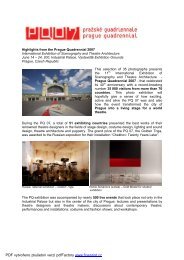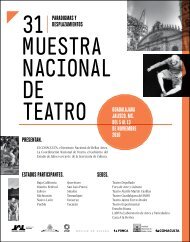- Page 4 and 5:
PRAŽSKÉ QUADRIENNALE JEVIŠTNÍHO
- Page 6 and 7:
COMITE DE LA QUADRIENNALE DE PRAGUE
- Page 8 and 9:
SEZNAM ZÚČASTNĚNÝCH STÁTU BELG
- Page 10 and 11:
INSCENACE HER A. P. ČECHOVA - TEMA
- Page 13 and 14:
BELGIE BELGIQUE BELGIUM GENERÁLNÍ
- Page 15 and 16:
throughout the country, as a counte
- Page 17 and 18:
1 K. Penderecki: Ďáblové z Loudu
- Page 19 and 20:
1 Euripides — H. Muller: Médea m
- Page 21 and 22:
E. Scribe: Medvěd a pasa / L'Ours
- Page 23 and 24:
A A V T^Ú^hOT°o B Koby T lin: Tar
- Page 25:
JEROME MAECKELBERGH W. Shakespeare:
- Page 28 and 29:
Janeiru) disponuje základním vyba
- Page 30 and 31:
SERRONI José Carlos Narozen 1950.
- Page 32 and 33:
30 JOSÉ CARLOS SERRONI Ch. De Assi
- Page 34 and 35:
scénografie celé expozice. Chtěj
- Page 36 and 37:
N. V. Gogol: Revizor / Le Revizor /
- Page 38 and 39:
Ch. Bojčev: Jak říkají Francouz
- Page 40 and 41:
38 SILVA BACVAROVOVÁ R. Kipling: P
- Page 42 and 43:
40 RUMEN DOBREV J. Radičkov: Sníh
- Page 44 and 45:
CAMi n O •i\ÍAH ig mm*l i if-ť
- Page 46 and 47:
,VJ5ÍT
- Page 49 and 50:
ČESKOSLOVENSKO TCHÉCOSLOVAQUIE CZ
- Page 51 and 52:
médien, 1'idée et 1'action ďautr
- Page 53 and 54:
nale jevištního a kostýmního v
- Page 55 and 56:
G. Verdi: Dva Foscariové / Deux Fo
- Page 57 and 58:
5 W. A. Mozart: Kouzelná flétna /
- Page 59 and 60:
10 N. V. Gogol: Revizor / Le Revizo
- Page 61 and 62:
9 K. Horký: Atlantida scéna déco
- Page 63 and 64:
10 11 12 M. Durši: Bertoldo scéna
- Page 65 and 66:
C. Debussy: Pelléas a Melisanda /
- Page 67 and 68:
8 V. Kašlík: Zbojnická balada /
- Page 69 and 70:
á Sao Paulo en 1965 la Médaille
- Page 71 and 72:
1 * \AJ TOMÁŠ RFRTCA A P Čechov
- Page 73 and 74:
J0ZEF CILLER W. Shakespeare: Cymbel
- Page 75 and 76:
MILAN Č0RBA R. Harwood: Garderobi
- Page 77 and 78:
MILAN FERENČIK W. Shakespeare: Per
- Page 79 and 80:
ALENA H0BL0VÁ , „, V. Trojan: Se
- Page 81 and 82:
JOSEF JELÍNEK A. Dvořák: Armida
- Page 83 and 84:
JARMILA KONEČNÁ , Č. Ajtmatov: D
- Page 85 and 86:
JAROSLAV MALINA I. Calvino: Baron v
- Page 87 and 88:
VLADIMÍR NYVLT A. Dvořák: Armida
- Page 89 and 90:
JOSEF SVOBODA W. A. Mozart: Idomene
- Page 91 and 92:
JOSEF SVOBODA E. Schorm — J. Kuč
- Page 93 and 94:
LADISLAV VYCHODIL W. Shakespeare: K
- Page 95 and 96:
JÁN ZAVARSKÝ , m r , „ . F. Hal
- Page 97 and 98:
ČINA CHINE CHINA GENERÁLNÍ KOMIS
- Page 99 and 100:
différents modes ďexpression, dep
- Page 101 and 102:
v Šanghaji / Théátre de musique
- Page 103 and 104:
Narozen 1936 v provincii Jiangsu. P
- Page 105 and 106:
Né en 1934 dans la province Sichua
- Page 107 and 108:
Né en 1942 a Shanghai. II travaill
- Page 109 and 110:
W. Shakespeare: Král Lear / Le Roi
- Page 111 and 112:
Narozen 1942 v provincii Yunan. Pra
- Page 113 and 114:
Né en 1927 dans la province Henan.
- Page 115 and 116:
Born in 1936 in the Liaoning provin
- Page 117 and 118:
Born in 1953 in Shanghai. Since 198
- Page 119 and 120:
CUI KEDI , W. Shakespeare: Zkrocen
- Page 121 and 122:
FAN SILIAN , „ „ . » , , „ .
- Page 123 and 124:
HAN JIYANG P. Shaffer: Equus 121
- Page 125 and 126:
LI CHANG Cao Yu: Pustina / Le Deser
- Page 127 and 128:
LI SUEN Zhong Lin: Vonící lilie /
- Page 129 and 130:
QI MUD0NG W. Shakespeare: Král Lea
- Page 131 and 132:
SHEN YAODING M. Twain: Princ a chud
- Page 133 and 134:
ZHANG JINGXIN , T _ . „ , . , Fen
- Page 135:
ZHU ZHANG Jing Cheng — Wei Zhong:
- Page 138 and 139:
která dramatický text ilustruje,
- Page 140 and 141:
Flůgare — Kl0vedal: Titanic scé
- Page 142 and 143:
140 KIRSTEN DEHLHOLM K. Dehlholm
- Page 144 and 145:
142 STURE PYK Moliěre: Tartuffe
- Page 146 and 147:
poloha naší země, která ztěžu
- Page 148 and 149:
En 1978 a la Triennale de décors e
- Page 150 and 151:
" , • - « fc -#x~ Wk RUNA AH0NEN
- Page 152 and 153:
150 LIISI TANDEFELTOVÁ A. J. Lerne
- Page 154 and 155:
nová scénografické řešení, kt
- Page 156 and 157:
zejména s A. Vitezem v Národním
- Page 158 and 159:
M. Durasová: Hudba II / La Musica
- Page 160 and 161:
Born in 1907 in Odessa, died in 198
- Page 162 and 163:
If xlx AG0STIN0 PÁCE J. Joyce: Exu
- Page 164 and 165:
162 GHISLAIN UHRY A. Pieyre de Mand
- Page 166 and 167:
divadla. V té době byl Island dá
- Page 168 and 169:
La Compagnie théátrale de Reykjav
- Page 170 and 171:
National Theatre was the realizatio
- Page 172 and 173:
REYNISSON Gretar SIGURDSSON Steinth
- Page 174 and 175:
172 GERLA M. Martin: Gertruda Stein
- Page 176 and 177:
174 SIGURJON JOHANSSON B. Brecht:
- Page 178 and 179:
176 STEINTHOR SIGURDSSON T. Thordar
- Page 180 and 181:
178 MESSÍANA T0MASDÓTTIR0VÁ T. S
- Page 182 and 183:
v Japonsku má dnes 380 členů. Or
- Page 184 and 185:
along with the history of performin
- Page 186 and 187: W. Shakespeare: Bouře / La Tempét
- Page 188 and 189: Born in 1948. He cooperates as cost
- Page 190 and 191: 1 G. Puccini: Madame Butterfly scé
- Page 192 and 193: Born in 1946 in Yamaguchi. He has b
- Page 194 and 195: 192 MITSURU ISHII W. Shakespeare: B
- Page 196 and 197: 194 Y0SHIK0 KUNISHIMA A. Dvořák:
- Page 198 and 199: 196 SACHIKO NAGASE N. Yamada: Fanta
- Page 201 and 202: JUGOSLÁVIE YOUGOSLAVIE YUGOSLAVIA
- Page 203 and 204: Narozena 1942 v Šabaci. Od 1965 sp
- Page 205 and 206: Né en 1921 a Slavonska Pozhega. II
- Page 207 and 208: zovou medaili na Triennale jevištn
- Page 209 and 210: W. Shakespeare: Sen noci svatojáns
- Page 211 and 212: Née en 1932 á Belgrade. Elle trav
- Page 213 and 214: MIROSLAV BLAGOJEVIC Ruzante: Moucha
- Page 215 and 216: SLAVICA LALICKI N. V. Gogol: Ženit
- Page 217 and 218: ' •• ' RUZICA NENADOVIČOVÁSOK
- Page 219 and 220: DORIAN SOKOLIČ A. Miller: Hon na
- Page 221 and 222: ŽIVOJIN TRAJANOVIC . n . .,,,.».
- Page 223 and 224: KUBA ČUBA GENERÁLNÍ KOMISAR JES
- Page 225 and 226: Born in 1937 in Havana. As stage an
- Page 227 and 228: E. Hernández Espinosa: Maria Anton
- Page 229 and 230: LAOS Laoská divadelní kultura je
- Page 231 and 232: Aprěs la révolution en 1975, la p
- Page 233 and 234: MAĎARSKO HONGRIE HUNGARY GENERÁLN
- Page 235: ďune remarquable troupe ayant une
- Page 239 and 240: et costumiěre au Jókai Théátre
- Page 241 and 242: Born in 1927 in Budapest. Since 196
- Page 243 and 244: scénographie et de costumes de th
- Page 245 and 246: £ R Mtalcz BýTvSrný až do smrti
- Page 247 and 248: MARTA JÁNOSKUTIOVÁ ^ , w „ „,
- Page 249 and 250: | • """ .p fioU I ' li PÍ fí i
- Page 251: • LÁSZLÓ SZÉKELY G. Rossini: L
- Page 254 and 255: Chceme znovu ukázat, jak jejich pr
- Page 256 and 257: HARNISCHOVÁ Jutta Narozena 1935 v
- Page 258 and 259: Born in 1953 in Berlin. Since 1979
- Page 260 and 261: in 1971 (in the exposition awarded
- Page 262 and 263: 260 EBERHARD KEIENBURG W. Shakespea
- Page 264 and 265: 262 KLAUS N0ACK H. Muller: Pověře
- Page 266 and 267: 264 HORST SAGERT J. W. Goethe: Urfa
- Page 269 and 270: NIZOZEMÍ PAYS-BAS NETHERLANDS GENE
- Page 271 and 272: ancienne usine sidérurgique. Depui
- Page 273: M. Berns — J. Hamilton — S. Tak
- Page 276 and 277: stupují pohostinsky v různých ko
- Page 278 and 279: the best offering from both foreign
- Page 280 and 281: Depuis 1979 il coopěre comme scén
- Page 282 and 283: odní sekci jsou vystaveny Pomalu t
- Page 284 and 285: The theatre made by Grzegorzewski i
- Page 287 and 288:
RUMUNSKO ROUMANIE RUMANIA GENERÁLN
- Page 289 and 290:
part se manifeste avec plus ďacuit
- Page 291 and 292:
Né en 1933. Scénographe et graveu
- Page 293 and 294:
Born in 1938. She has been working
- Page 295 and 296:
1 L Rebreanu - M. Sorbu: Ion scéna
- Page 297 and 298:
IULIANA MANT0C0VÁ W. Shakespeare:
- Page 299:
VASILE ROTARU A. Kiritescu: Povídk
- Page 302 and 303:
L'exposition des Etats-Unis prend c
- Page 304 and 305:
Ne en 1947 a New York. II coopěre
- Page 306 and 307:
aíd tele S visio S n Sned " ^ C °
- Page 308 and 309:
306 PATT0N CAMPBELL B. Brecht: Žeb
- Page 310 and 311:
308 RALPH FUNICELLO W. Shakespeare:
- Page 312 and 313:
310 JOHN MALOLEPSY C. Monteverdi: K
- Page 314 and 315:
312 BENI M0NTRES0R J. Stein—S. Sc
- Page 317 and 318:
SPOLKOVÁ REPUBLIKA NĚMECKA RÉPUB
- Page 319 and 320:
A. P. Čechov: Višňový sad / La
- Page 321 and 322:
A. P. Čechov: Strýček Váňa / O
- Page 323 and 324:
GÁBY FREYOVÁ A. P. Čechov: Tři
- Page 325:
JURGEN ROSE A. P. Čechov: Višňov
- Page 328 and 329:
a republikách naší země. Tato v
- Page 330 and 331:
BARCHIN Sergej Narozen 1938. Jako s
- Page 332 and 333:
ge design Leningradskij Gosudarstve
- Page 334 and 335:
10 11 Višňový sad / La Cerisaie
- Page 336 and 337:
important theatres in Moscow. In 19
- Page 338 and 339:
336 DAVID B0R0VSKIJ A. P. Čechov:
- Page 340 and 341:
338 EDUARD K0ČERGIN A. P. Čechov:
- Page 342 and 343:
340 VLADIMÍR SEREBROVSKIJ A. P. Č
- Page 345 and 346:
ŠPANĚLSKO (KATALÁNIE) ESPAGNE (C
- Page 347 and 348:
Vu le fait qu'il faut avoir des lie
- Page 349 and 350:
sents at the Prague Quadrennial 198
- Page 351 and 352:
FABIÁ PUIGSERVER C Goldoni: Posled
- Page 353:
^ p £j># -^ •3 ř-. FABIÁ PUIGS
- Page 356 and 357:
ko většiny evropských divadel je
- Page 358 and 359:
The exhibition presents some exampl
- Page 360 and 361:
une Médaille de Bronze pour les co
- Page 362 and 363:
ULLA KASSIUSOVÁ A. Pleijelová: Sv
- Page 364 and 365:
362 GUNILLA PALMSTIERNA-WEISSOVÁ W
- Page 367 and 368:
ŠVÝCARSKO SUISSE SWISS GENERÁLN
- Page 369 and 370:
Pautrefois. Ce personnage est exact
- Page 371:
S K S I Proti své rtll / Le Méde
- Page 374 and 375:
expozice v Praze byla co nejrepreze
- Page 376 and 377:
designers, who obtained their resul
- Page 378 and 379:
a joue par ex. les piěces de Moli
- Page 380 and 381:
\ r
- Page 383 and 384:
BULHARSKO BULGARIE BULGARIA Narozen
- Page 385 and 386:
ČESKOSLOVENSKO TCHÉCOSLOVAQUIE CZ
- Page 387 and 388:
Údaje viz v oddíle I. Les dates v
- Page 389 and 390:
Faculté théátrale a PAcadémie d
- Page 391 and 392:
Strýček Váňa / Oncle Vania / Un
- Page 393 and 394:
(collective) pour la scénographie
- Page 395 and 396:
Hra bez názvu — Platonov / Le Je
- Page 397 and 398:
Tři sestry / Les Trois Soeurs / Th
- Page 399 and 400:
FINSKO FINLANDE FINLAND Narozen 194
- Page 401 and 402:
FRANCIE FRANCE Údaje viz v oddíle
- Page 403 and 404:
JAPONSKO JAPON JAPAN Historické in
- Page 405 and 406:
Údaje viz v oddíle I. Les dates v
- Page 407:
KANADA CANADA 1967—1987 navrhl v
- Page 410 and 411:
Višňový sad / La Cerisaie / The
- Page 413:
NOVÝ ZÉLAND NOUVELLE-ZELANDE NEW
- Page 416 and 417:
JANKOWSKÁ Narozena 1931 ve Varšav
- Page 418 and 419:
Višňový sad / La Cerisaie / The
- Page 420 and 421:
418 GE0RGIIVANOV Tři sestry / Les
- Page 422 and 423:
1 JOZEF CILLER Višňový sad / La
- Page 424 and 425:
422 MICHAL HESS Racek / La Mouette
- Page 426 and 427:
424 ZBYNĚK KOLÁŘ Ivanov
- Page 428 and 429:
426 GITA P0LÓNY0VÁ Višňový sad
- Page 430 and 431:
m~jm VAKÍWÍA MARTA R0SZK0PF0VÁ V
- Page 432 and 433:
430 JINDŘICH SMETANA Černý mnich
- Page 434 and 435:
432 JOSEF SVOBODA Tři sestry / Les
- Page 436 and 437:
434 OTTO ŠUJAN Ivanov
- Page 438 and 439:
436 LADISLAV VYCHODIL Platonov
- Page 440 and 441:
SHIGEO KAWAMORI Višňový sad / La
- Page 442 and 443:
440 YOSHIE SÁGA Višňový sad / L
- Page 444 and 445:
442 MARTA JÁNOSKUTIOVÁ Racek / La
- Page 446 and 447:
444 LESZEK MADZIK — LILIANA JANKO
- Page 448 and 449:
446 ROMULUS FENES Višňový sad /
- Page 451:
BELGIE BELGIQUE BELGIUM V roce 1986
- Page 454 and 455:
ťy^ngt— *Q» m DIVADLO V PŘÍRO
- Page 456 and 457:
ČINOHERNÍ DIVADLO / THEATRE DRAMA
- Page 458 and 459:
456 OPERNÍ, ČINOHERNÍ A BALETNÍ
- Page 460 and 461:
458 OPERA PLOVDIV 1985 sály s 1000
- Page 462 and 463:
NIKOLA SLAVOV Narozen 1954. Né en
- Page 465 and 466:
ČESKOSLOVENSKO TCHÉCOSLOVAQUE CZE
- Page 467 and 468:
2 DIVADLO JIŘÍHO MYRONA / THEATRE
- Page 469 and 470:
--y% 10 VÝCHODNÍ FASÁDA ±0 = 23
- Page 471 and 472:
1 ZASTŘEŠENÍ LETNÍHO KINA / LA
- Page 473 and 474:
REKONSTRUKCE DIVADLA J. K. TYLA / R
- Page 475 and 476:
„It STŘEDISKO A REKONSTRUKCE HRA
- Page 477 and 478:
KULTURNÍ DÚM ROH / MAISON CULTURE
- Page 479 and 480:
of a new building with a drama audi
- Page 481 and 482:
divadelních souborů s kapacitou 5
- Page 483 and 484:
HUDEBNÍ DIVADLO V PRAZE-KARLÍNÉ
- Page 485 and 486:
3 DIVADLO SLOVENSKÉHO NÁRODNÍHO
- Page 487 and 488:
FINSKO FINLANDE FINLAND DIVADLO V P
- Page 489 and 490:
FRANCIE FRANCE Expozice divadelní
- Page 491 and 492:
KONGRESOVÝ SÁL V PLODINOVÉ HALE
- Page 493 and 494:
' " 3 KULTURNÍ STŘEDISKO V JÍZD
- Page 495 and 496:
KRATSKÁ NÁRODNÍ KONZERVATOŘ HUD
- Page 497 and 498:
spoluautoři / co-auteurs / co-auth
- Page 499:
autoři projektů / auteurs des pro
- Page 502 and 503:
PROJET ENVOYE DANS LE CONCOURS D'AR
- Page 504 and 505:
spoluautoři / co-auteurs / co-auth
- Page 507 and 508:
JUGOSLÁVIE YOUGOSLAVIE YUGOSLAVIA
- Page 509 and 510:
NĚMECKÁ DEMOKRATICKÁ REPUBLIKA R
- Page 511 and 512:
Poškozeni stavby, opotřebovaná j
- Page 513 and 514:
es de 1'ensemble ont mené a la dé
- Page 515:
econstruction, which would fulfill
- Page 518 and 519:
This complex consists of: main hal
- Page 521 and 522:
RUMUNSKO ROUMANIE RUMANIA MODEL DIV
- Page 523:
PAUL BORTNOVSKI Údaje viz v oddíl
- Page 526 and 527:
MĚSTSKÝ SÁL / SALLE MUNICIPALE /
- Page 528 and 529:
Cette vaste reconstruction a été
- Page 530 and 531:
528
- Page 532 and 533:
DIVADLO / THEATRE / THEATRE NORRBOT



